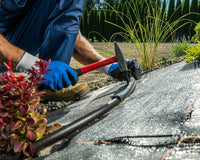Summer brings warm days and longer daylight hours, which means more time to enjoy your outdoor spaces, including your beautiful lawn.
However, the hot summer sun can be harsh on your grass, leading to dryness, browning, and potential damage.

To ensure your lawn remains vibrant and lush during the hottest months, we have compiled ten essential tips that will help you protect your lawn during hot summer days.
From proper watering techniques to lawn care practices, we've got you covered.
Read on to discover how to keep your lawn in its best shape even in scorching temperatures!

10 Tips to Protect Your Lawn During Hot Summer Days
1. Water Early in the Morning
Proper watering is crucial during hot summer days. Watering your lawn early in the morning, preferably between 5 a.m. and 9 a.m., allows the grass to absorb the moisture before the sun becomes too intense. This helps prevent water loss due to evaporation, ensuring your lawn stays adequately hydrated throughout the day.
2. Deep and Infrequent Watering
Instead of frequent shallow watering, aim for deep and infrequent watering sessions. Deep watering encourages grass roots to grow deeper into the soil, making them more resilient to drought and heat stress. Ideally, your lawn should receive about 1 to 1.5 inches of water per week, either from rainfall or irrigation.
3. Use a Soaker Hose or Drip Irrigation
Consider using a soaker hose or drip irrigation system for watering your lawn. These methods deliver water directly to the roots, minimizing wastage and ensuring more efficient water absorption. Avoid using sprinklers during the hottest parts of the day, as much of the water can evaporate before reaching the roots.
4. Mow High and Frequently
When mowing your lawn during summer, set the mower to a higher cutting height. Longer grass provides shade to the soil, reducing evaporation and maintaining moisture levels. Additionally, regular mowing prevents the grass from becoming too tall, which can stress the plants during hot weather.

5. Keep Your Mower Blades Sharp
Dull mower blades tear the grass instead of cutting it cleanly. This can lead to ragged edges, making the grass more susceptible to water loss and diseases. Regularly sharpen your mower blades to ensure clean and precise cuts, promoting healthier grass growth.
6. Apply Mulch Around Trees and Shrubs
Mulching around trees and shrubs not only enhances the aesthetics of your lawn but also helps retain soil moisture. Organic mulch, such as wood chips or shredded leaves, acts as a protective layer, reducing water evaporation and preventing weed growth.
7. Consider Using Shade Structures
If your lawn receives prolonged exposure to the sun, consider installing shade structures like pergolas or umbrellas. Providing shade during the hottest parts of the day can protect your lawn from scorching heat and maintain its health and color.
8. Fertilize Wisely
During summer, avoid using excessive nitrogen-based fertilizers, as they can promote fast growth, making the grass more vulnerable to stress and diseases. Opt for slow-release or organic fertilizers that provide a steady supply of nutrients without causing rapid growth spurts.
9. Keep Foot Traffic to a Minimum
Minimize foot traffic on your lawn during hot summer days, as constant trampling can damage the grass and compact the soil. Restrict activities like playing sports or hosting events on the grass, especially when the temperatures are soaring.
10. Watch for Pest and Disease Infestations
Hot and dry conditions can attract pests and make your lawn susceptible to diseases. Keep a close eye on any signs of infestations, such as brown patches or insect activity, and take prompt action to address the issue.

Frequently Asked Questions (FAQs)
Q: How often should I water my lawn during hot summer days?
A: Water your lawn deeply and infrequently, aiming for about 1 to 1.5 inches of water per week, either from rainfall or irrigation.
Q: Is it essential to mow my lawn frequently during summer?
A: Yes, regular mowing is crucial during summer. However, set your mower to a higher cutting height to provide shade to the soil and prevent water loss.
Q: Can I use a sprinkler to water my lawn during hot afternoons?
A: It is best to avoid using sprinklers during the hottest parts of the day, as much of the water can evaporate before reaching the roots. Consider using a soaker hose or drip irrigation system instead.
Q: How can I protect my lawn from pests during summer?
A: Keep a close eye on any signs of pest infestations, such as brown patches or insect activity, and take prompt action to address the issue. Consider using natural pest control methods before resorting to chemical solutions.
Q: Should I apply fertilizer to my lawn during summer?
A: Yes, but be cautious with the type of fertilizer you use. Avoid excessive nitrogen-based fertilizers and opt for slow-release or organic options to prevent rapid growth spurts.

With the right care and attention, you can protect your lawn and keep it looking vibrant and healthy even during the hottest summer days.
By following the ten tips mentioned in this article, you'll ensure your lawn stays adequately hydrated, shaded, and well-maintained.
Remember to water early in the morning, mow at the appropriate height, and be vigilant for any signs of pest or disease infestations.
By incorporating these practices into your lawn care routine, you can enjoy a lush and beautiful lawn throughout the summer season.





